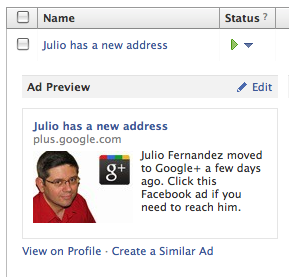Surprise! Facebook Has No Problem Running Ads for Users’ Google+ Accounts
TechCrunch has uncritically reported that the first-ever advertisement on Facebook for a Google+ account has been taken down, but subsequent users attempting the same trick have encountered no resistance from the company.

First, a little background: Facebook reserves the right to refuse any ad for any reason, and specifically forbids ads for competing services, so it would be well within its rights to ban any such ad.
However, when marketing strategist and Google+ user Julio Fernandez attempted to reproduce the experiment, he failed. That is, he was successful in posting an ad to Facebook that advertises his profile in Google+.

So which is it—is Facebook banning users from posting ads for Google+, or isn’t it? Or is it selectively applying its terms of service?
Michael Johnson, who posted the original ad, has sent along a screenshot of the rejection email Facebook sent him. It appears legit—which means that Facebook is inconsistently applying its ad standards when it comes to Google+ ads. Possibly, according to this thread on Hacker news, because the ad approval process itself is semi-automated.
Johnson’s initial announcement of his experiment, trumpets “CALLING ALL JOURNALISTS, BLOGGERS & TECHNOPHILES” and ends with the call to action “COVERAGE NEEDED: PLEASE SHARE.” (Emphasis his.)
Johnson’s announcement of the banning of his ad carried similar calls to action, and he lists “Marketing, Advertising, SEO” under his occupations. In short, everything about this smells like a too-perfect attempt to generate as much publicity as possible. But if Facebook really did ban Johnson’s ad, that’s to his credit—because it worked.
Keep Reading
Most Popular
Large language models can do jaw-dropping things. But nobody knows exactly why.
And that's a problem. Figuring it out is one of the biggest scientific puzzles of our time and a crucial step towards controlling more powerful future models.
The problem with plug-in hybrids? Their drivers.
Plug-in hybrids are often sold as a transition to EVs, but new data from Europe shows we’re still underestimating the emissions they produce.
How scientists traced a mysterious covid case back to six toilets
When wastewater surveillance turns into a hunt for a single infected individual, the ethics get tricky.
Google DeepMind’s new generative model makes Super Mario–like games from scratch
Genie learns how to control games by watching hours and hours of video. It could help train next-gen robots too.
Stay connected
Get the latest updates from
MIT Technology Review
Discover special offers, top stories, upcoming events, and more.